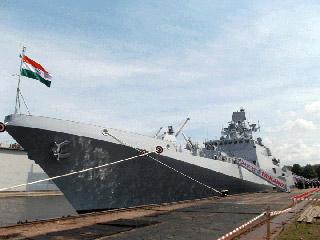
The IRNSS-1A (Indian Regional Navigation Satellite System) undergoing checks in the clean room at Sriharikota. Photo: ISRO.
CHENNAI (PTI): India's first dedicated navigation satellite IRNSS-1A will be launched onboard PSLV-C22 around midnight on Monday from the spaceport of Sriharikota with the mission countdown progressing smoothly.
ISRO's workhorse Polar Satellite Launch Vehicle (PSLV) is scheduled to blast off from the Satish Dhawan Space Centre at Sriharikota, about 80 km from here, at 11.41 PM carrying the satellite.
"The 64-and-a-half hour countdown for the launch has begun at 7.11 AM yesterday and is progressing smoothly. Everything is on schedule and the launch would take place at 11.41 pm on Monday," Indian Space Research Organisation (ISRO) spokesman Deviprasad Karnik told PTI on Sunday.
The 1,425 kg IRNSS-1A, the first satellite in Indian Regional Navigation Satellite System (IRNSS), has a mission life of 10 years and would provide accurate real-time position and timing information to users in the country as well as the region extending up to 1,500 km around it, ISRO said.
The IRNSS-1A, carrying two types of payloads - navigation and ranging payloads - would be injected into space about 20 minutes after lift-off.
On the unusual midnight launch, the first from Sriharikota, ISRO sources said the time for every launch was determined by the orbital parameters and inclination. Taking into consideration the requirements of IRNSS-1A, it had been fixed at 11.41 PM.
With a lift-off mass of 1,425 kg, the satellite also has two solar panels. Special thermal control schemes have been designed and implemented for some of the critical elements such as atomic clocks.
The IRNSS system, which would ultimately have seven satellites, was targeted to be completed by 2015 at a total cost of Rs 1,420 crores, ISRO sources said.
Applications of IRNSS include terrestrial aerial and marine navigation, disaster management, vehicle tracking and fleet management, navigation aide for hikers and travellers, visual and voice navigation for drivers, they said.
The fully deployed IRNSS system would consist of three satellites in GEO stationary orbit and four in inclined geosynchronous orbit, about 36,000 km altitude above earth.
The powerful "XL" version of the PSLV is being used in Monday's launch which would be the 24th mission of the rocket. Barring the failure of first mission in 1993, all the 22 subsequent PSLV flights till February this year have been successful.
This is the fourth occasion that ISRO is using an 'XL' version, the earlier launches being Chandrayaan 1 (PSLV-C11), GSAT-12 (PSLV-C17) and RISAT-1 (PSLV-C19).
 Previous Article
Previous Article Next Article
Next Article













The Indian Air Force, in its flight trials evaluation report submitted before the Defence Ministry l..
view articleAn insight into the Medium Multi-Role Combat Aircraft competition...
view articleSky enthusiasts can now spot the International Space Station (ISS) commanded by Indian-American astr..
view article